JAVA复习题1(1)
Java基础试题及其答案(1)
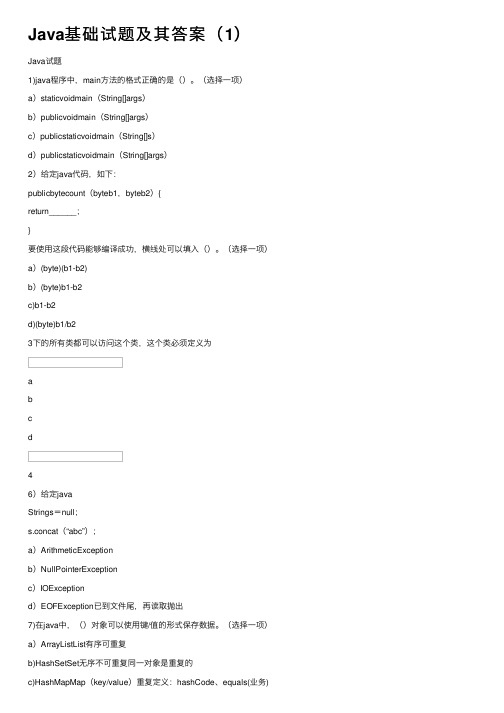
Java基础试题及其答案(1)Java试题1)java程序中,main⽅法的格式正确的是()。
(选择⼀项)a)staticvoidmain(String[]args)b)publicvoidmain(String[]args)c)publicstaticvoidmain(String[]s)d)publicstaticvoidmain(String[]args)2)给定java代码,如下:publicbytecount(byteb1,byteb2){return______;}要使⽤这段代码能够编译成功,横线处可以填⼊()。
(选择⼀项)a)(byte)(b1-b2)b)(byte)b1-b2c)b1-b2d)(byte)b1/b23下的所有类都可以访问这个类,这个类必须定义为abcd46)给定javaStrings=null;s.concat(“abc”);a)ArithmeticExceptionb)NullPointerExceptionc)IOExceptiond)EOFException已到⽂件尾,再读取抛出7)在java中,()对象可以使⽤键/值的形式保存数据。
(选择⼀项)a)ArrayListList有序可重复b)HashSetSet⽆序不可重复同⼀对象是重复的c)HashMapMap(key/value)重复定义:hashCode、equals(业务)d)LinkedListList8)给定如下java代码,编译运⾏之后,将会输出()。
publicclassTest{publicstaticvoidmain(Stringargs[]){inta=5;((a%2==1)?(a+1)/2:a/2);三⽬表达式}}(选择⼀项)a)1b)2c)2.5d)39)以下Java语句中,Stringstr=“”;str=str.subString(1,3);执⾏后str中的值为。
(选择⼀项)subString ⼦串[1,3) a)“23”b)“123”c)“12”d)“234”10)给定如下java代码,以下()代码⾏编译会报错。
JAVA试题1

A.线程就是程序
B.线程是一个程序的单个执行流
C.多线程是指一个程序的多个执行流
D.多线程用于实现并发
11.已知 x=2, y=3, z=4,则经过 z- = --y – x--运算后,z 的值为( D )。
(A)1
(B)2
(C)3
(D)4
12.表达式(12==0) && (1/0 < 1)的值为( B )。
5.下列哪种类成员修饰符修饰的变量只能在本类中被访问?( D )
(A)protected (B)public (C)default (D)private
6.下面关于类的说法,不正确的是( C )。
(A)类是同种对象的集合和抽象 (B)类属于 Java 语言中的复合数据类型
(C)类就是对象
(D)对象是 Java 语言中的基本结构单位 Nhomakorabea为( D )
(A)abstract void f()
(B)public void f()
(C)final void f()
(D)static void f()
9.定义外部类的类头时,不可用的关键字是( C )。
A.public
B.final
C.protected
D.Abstract
10.下列说法中,错误的一项是( A )。
2.Java 语言属于( B )种语言?
(A)面向机器的语言
(B)面向对象的语言
(C)面向过程的语言
(D)面向操作系统的语言
3.Java 语言类间的继承关系是( A )。
A.单继承
B.多重继承
C.不能继承
D.不一定
4.下列( D )是合法的标识符?
(A)12class (B)void
《Java基础入门》(第二版)习题汇总(1)

1.1 习题一、填空题1、Java的三大体系分别是______、______、______。
2、Java程序的运行环境简称之为______。
3、编译Java程序需要使用______命令。
4、javac.exe和java.exe两个可执行程序存放在JDK安装目录的______目录下。
5、______环境变量用来存储Java的编译和运行工具所在的路径,而______环境变量则用来保存保存Java虚拟机要运行的“.class”文件路径。
二、判断题1、通过Java虚拟机可以在不同的操作系统上运行Java程序,从而实现跨平台特性。
2、JRE中又包含了Java基础类库、JVM和开发工具。
3、Java中的包是专门用来存放类的,通常功能相同的类存放在相同的包中。
4、java.util:包含Java中大量工具类、集合类等,例如Arrays、List、Set等。
5、Java语言和C语言一样,是面向过程的语言。
三、选择题1、以下选项中,哪些属于JDK工具?(多选)A、Java编译器B、Java运行工具C、Java文档生成工具D、Java打包工具2、Java属于以下哪种语言?A、机器语言B、汇编语言C、高级语言D、以上都不对3、下面哪种类型的文件可以在Java虚拟机中运行?A、.javaB、.jreC、.exeD、.class4、安装好JDK后,在其bin目录下有许多exe可执行文件,其中java.exe命令的作用是以下哪一种?A、Java文档制作工具B、Java解释器C、Java编译器D、Java启动器5、如果jdk的安装路径为:d:\jdk,若想在命令窗口中任何当前路径下,都可以直接使用javac和java命令,需要将环境变量path设置为以下哪个选项?A.d:\jdk; B.d :\jdk\bin; C.d:\jre\bin; D.d:\jre;四、简答题1、简述Java的特点。
2、简述JRE与JDK的区别。
3、简述Java的运行机制。
JAVA期末复习题及答案——第一章
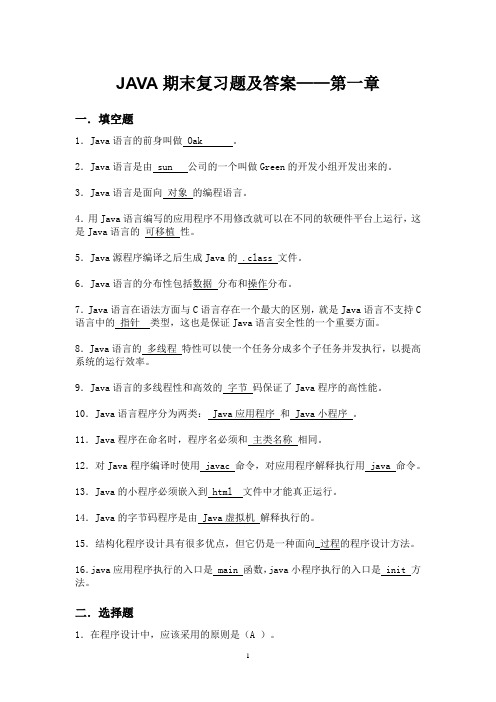
JAVA期末复习题及答案——第一章一.填空题1.Java语言的前身叫做 Oak 。
2.Java语言是由 sun 公司的一个叫做Green的开发小组开发出来的。
3.Java语言是面向对象的编程语言。
4.用Java语言编写的应用程序不用修改就可以在不同的软硬件平台上运行,这是Java语言的可移植性。
5.Java源程序编译之后生成Java的 .class 文件。
6.Java语言的分布性包括数据分布和操作分布。
7.Java语言在语法方面与C语言存在一个最大的区别,就是Java语言不支持C 语言中的指针类型,这也是保证Java语言安全性的一个重要方面。
8.Java语言的多线程特性可以使一个任务分成多个子任务并发执行,以提高系统的运行效率。
9.Java语言的多线程性和高效的字节码保证了Java程序的高性能。
10.Java语言程序分为两类: Java应用程序和 Java小程序。
11.Java程序在命名时,程序名必须和主类名称相同。
12.对Java程序编译时使用 javac 命令,对应用程序解释执行用 java 命令。
13.Java的小程序必须嵌入到 html 文件中才能真正运行。
14.Java的字节码程序是由 Java虚拟机解释执行的。
15.结构化程序设计具有很多优点,但它仍是一种面向_过程的程序设计方法。
16.java应用程序执行的入口是 main 函数,java小程序执行的入口是 init 方法。
二.选择题1.在程序设计中,应该采用的原则是(A )。
A、程序结构有助于读者理解B、不限制GOTO语句的使用C、减少或取消注释行D、程序越短越好2.保证Java语言可移植性的特征是(D )。
A、面向对象B、安全性C、分布式计算D、可跨平台3.以下选项中不属于Java语言的特点的是(B )A、面向对象B、平台相关性C、分布式D、多线程性4.以下关于Java语言的叙述中,错误的是(D )A、Java的解释器提供了数组下标越界的检查B、Java语言是一种面向对象的编程语言C、Java在编译和运行时,都要对可能出现的问题进行检查D、Java支持C语言中的goto语句5.Java语言与C++语言相比,最突出的特点是(B )A、面向对象B、跨平台C、有类库D、高性能6.运行java程序所需要的工具软件所在的目录是(A)A、JDK的bin目录B、JDK的demo目录C、JDK的lib目录D、JDK的jre目录7.下列叙述中,错误的是 DA、Java Application与Applet所用编译命令相同B、通常情况下Java Application只能有一个main()方法C、Java Applet必须有HTML文件才能运行D、Java Applet程序的.class文件可用java命令运行8.在Java语言中,不允许使用指针体现出的Java特性是(D)A、可移植B、解释执行C、健壮性D、安全性9.在Java中,负责对字节代码进行解释的是(B )。
java复习题1-模拟试卷
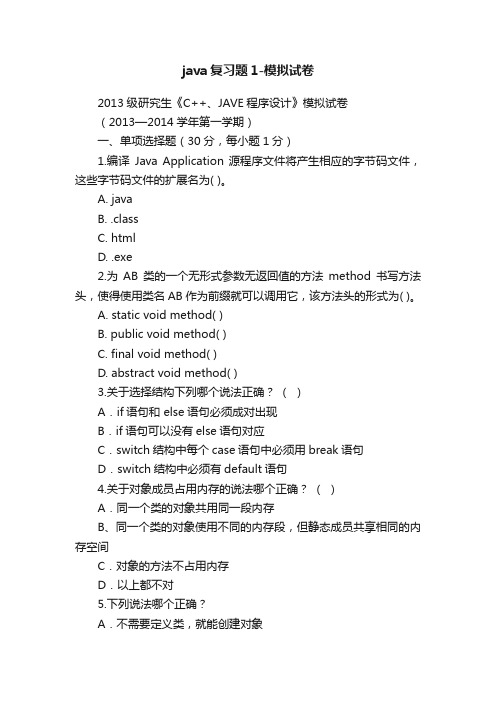
java复习题1-模拟试卷2013级研究生《C++、JAVE程序设计》模拟试卷(2013—2014学年第一学期)一、单项选择题(30分,每小题1分)1.编译Java Application 源程序文件将产生相应的字节码文件,这些字节码文件的扩展名为( )。
A. javaB. .classC. htmlD. .exe2.为AB类的一个无形式参数无返回值的方法method书写方法头,使得使用类名AB作为前缀就可以调用它,该方法头的形式为( )。
A. static void method( )B. public void method( )C. final void method( )D. abstract void method( )3.关于选择结构下列哪个说法正确?()A.if语句和 else语句必须成对出现B.if语句可以没有else语句对应C.switch结构中每个case语句中必须用break语句D.switch结构中必须有default语句4.关于对象成员占用内存的说法哪个正确?()A.同一个类的对象共用同一段内存B、同一个类的对象使用不同的内存段,但静态成员共享相同的内存空间C.对象的方法不占用内存D.以上都不对5.下列说法哪个正确?A.不需要定义类,就能创建对象B.对象中必须有属性和方法C.属性可以是简单变量,也可以是一个对象D、属性必须是简单变量6.关于方法main()的说法哪个正确?()A.方法main()只能放在公共类中B main()的头定义可以根据情况任意更改C.一个类中可以没有main()方法D.所有对象的创建都必须放在main()方法中7.构造函数何时被调用?()A、创建对象时B、类定义时C、使用对象的方法时D、使用对象的属性时8.抽象方法:()A、可以有方法体B、可以出现在非抽象类中C、是没有方法体的方法D、抽象类中的方法都是抽象方法9.关于继承的说法正确的是:()A、子类将继承父类所有的属性和方法。
10112Java复习资料(答案)(1)
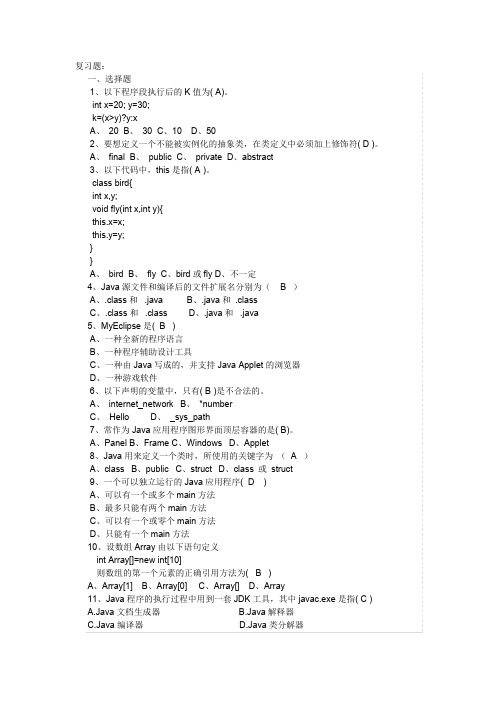
复习题:一、选择题1、以下程序段执行后的 K 值为( A)。
int x=20; y=30;k=(x>y)?y:xA、 20 B、 30 C、10 D、502、要想定义一个不能被实例化的抽象类,在类定义中必须加上修饰符( D )。
A、 final B、 public C、 private D、abstract3、以下代码中,this 是指( A )。
class bird{int x,y;void fly(int x,int y){this.x=x;this.y=y;}}A、 bird B、 fly C、bird 或 fly D、不一定4、Java 源文件和编译后的文件扩展名分别为( B )A、.class 和 .javaB、.java 和 .classC、.class 和 .class D、.java 和 .java5、MyEclipse 是( B )A、一种全新的程序语言B、一种程序辅助设计工具C、一种由 Java 写成的,并支持 Java Applet 的浏览器D、一种游戏软件6、以下声明的变量中,只有( B )是不合法的。
A、 internet_network B、 *numberC、 Hello D、 _sys_path7、常作为 Java 应用程序图形界面顶层容器的是( B)。
A、Panel B、Frame C、Windows D、Applet8、Java 用来定义一个类时,所使用的关键字为 ( A )A、class B、public C、struct D、class 或 struct9、一个可以独立运行的 Java 应用程序( D )A、可以有一个或多个 main 方法B、最多只能有两个 main 方法C、可以有一个或零个 main 方法D、只能有一个 main 方法10、设数组 Array 由以下语句定义int Array[]=new int[10]则数组的第一个元素的正确引用方法为( B )A、Array[1] B、Array[0] C、Array[] D、Array11、Java 程序的执行过程中用到一套 JDK 工具,其中 javac.exe 是指( C )A.Java 文档生成器B.Java 解释器C.Java 编译器D.Java 类分解器12、以 public 修饰的类如:public class Car{…} 则 Car( A )A、可被其它程序包中的类使用 B、仅能被本程序包中的类使用C、不能被任意其它类使用 D、不能被其它类继承13、下列哪个属于容器型构件( C )A JEdit B JButton C JPanel D JTextField14、JDK 是( B )A、一种全新的程序语言B、一种程序开发辅助工具C、一种由 Java 写成的,并支持 Java Applet 的浏览器D、一种游戏软件]15、下面关于 Applet 的说法正确的是 ( B)A、 Applet 也需要 main 方法B、 Applet 必须继承自 java.awt.AppletC、 Applet 能访问本地文件D、 Applet 程序不需要编译16、 Java 语言中下面哪个可以用作正确的变量名称( B )A、3D B、name C、extends D、implements17、 下面关于构造函数的说法不正确的是( B )A、构造函数也属于类的方法,用于创建对象的时候给成员变量赋值。
JAVA期末复习和答案1
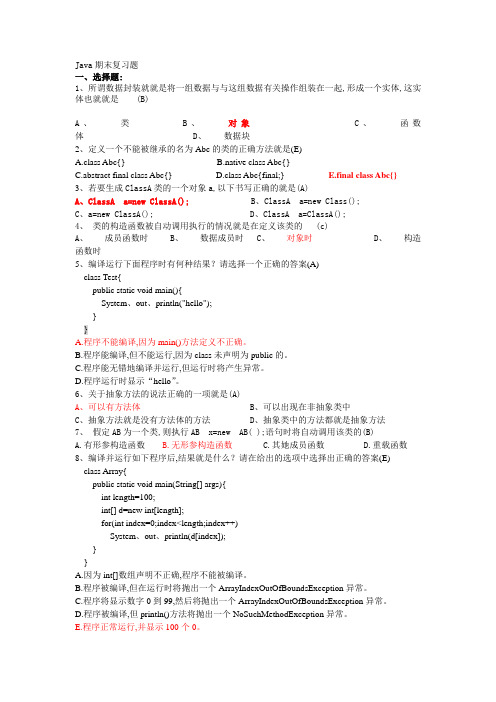
Java期末复习题一、选择题:1、所谓数据封装就就是将一组数据与与这组数据有关操作组装在一起,形成一个实体,这实体也就就是 (B)A、类B、对象C、函数体D、数据块2、定义一个不能被继承的名为Abc的类的正确方法就是(E)A.class Abc{}B.native class Abc{}C.abstract final class Abc{}D.class Abc{final;}E.final class Abc{}3、若要生成ClassA类的一个对象a,以下书写正确的就是(A)A、ClassA a=new ClassA();B、ClassA a=new Class();C、a=new ClassA();D、ClassA a=ClassA();4、类的构造函数被自动调用执行的情况就是在定义该类的(c)A、成员函数时B、数据成员时C、对象时D、构造函数时5、编译运行下面程序时有何种结果?请选择一个正确的答案(A)class Test{public static void main(){System、out、println("hello");}}A.程序不能编译,因为main()方法定义不正确。
B.程序能编译,但不能运行,因为class未声明为public的。
C.程序能无错地编译并运行,但运行时将产生异常。
D.程序运行时显示“hello”。
6、关于抽象方法的说法正确的一项就是(A)A、可以有方法体B、可以出现在非抽象类中C、抽象方法就是没有方法体的方法D、抽象类中的方法都就是抽象方法7、假定AB为一个类,则执行AB x=new AB( );语句时将自动调用该类的(B)A.有形参构造函数B.无形参构造函数C.其她成员函数D.重载函数8、编译并运行如下程序后,结果就是什么?请在给出的选项中选择出正确的答案(E)class Array{public static void main(String[] args){int length=100;int[] d=new int[length];for(int index=0;index<length;index++)System、out、println(d[index]);}}A.因为int[]数组声明不正确,程序不能被编译。
Java高级语言程序设计期末复习资料(1)
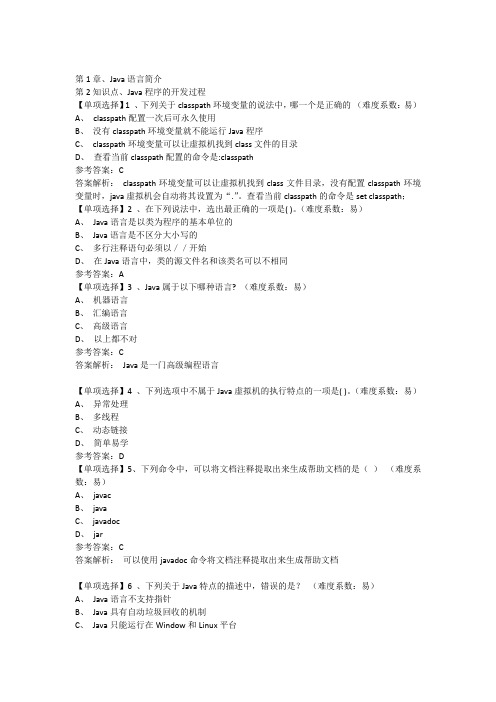
第1章、Java语言简介第2知识点、Java程序的开发过程【单项选择】1 、下列关于classpath环境变量的说法中,哪一个是正确的(难度系数:易)A、classpath配置一次后可永久使用B、没有classpath环境变量就不能运行Java程序C、classpath环境变量可以让虚拟机找到class文件的目录D、查看当前classpath配置的命令是:classpath参考答案:C答案解析:classpath环境变量可以让虚拟机找到class文件目录,没有配置classpath环境变量时,java虚拟机会自动将其设置为“.”。
查看当前classpath的命令是set classpath;【单项选择】2 、在下列说法中,选出最正确的一项是( )。
(难度系数:易)A、Java语言是以类为程序的基本单位的B、Java语言是不区分大小写的C、多行注释语句必须以//开始D、在Java语言中,类的源文件名和该类名可以不相同参考答案:A【单项选择】3 、Java属于以下哪种语言? (难度系数:易)A、机器语言B、汇编语言C、高级语言D、以上都不对参考答案:C答案解析:Java是一门高级编程语言【单项选择】4 、下列选项中不属于Java虚拟机的执行特点的一项是( )。
(难度系数:易)A、异常处理B、多线程C、动态链接D、简单易学参考答案:D【单项选择】5、下列命令中,可以将文档注释提取出来生成帮助文档的是()(难度系数:易)A、javacB、javaC、javadocD、jar参考答案:C答案解析:可以使用javadoc命令将文档注释提取出来生成帮助文档【单项选择】6 、下列关于Java特点的描述中,错误的是?(难度系数:易)A、Java语言不支持指针B、Java具有自动垃圾回收的机制C、Java只能运行在Window和Linux平台D、Java允许多个线程同时执行参考答案:C答案解析:JAVA是一门面向对象的语言,它没有指针的概念,并提供了自动垃圾回收的机制,具有跨平台,多线程等特点。
Java复习1
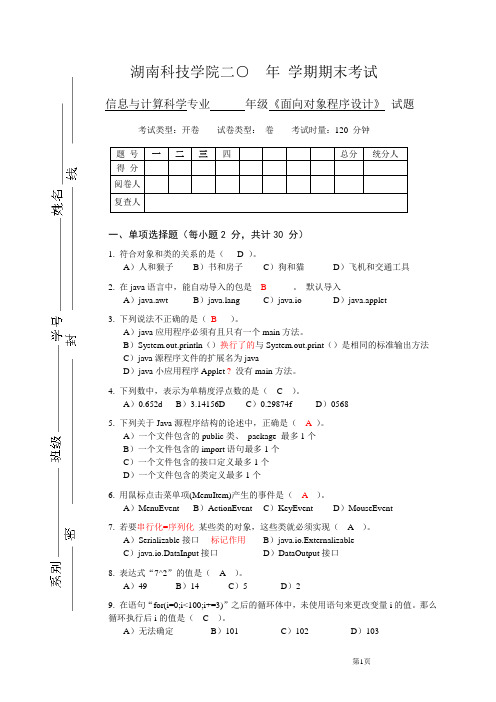
湖南科技学院二○ 年 学期期末考试信息与计算科学专业 年级《面向对象程序设计》 试题考试类型:开卷 试卷类型: 卷 考试时量:120 分钟 一、单项选择题(每小题2 分,共计30 分)1. 符合对象和类的关系的是( D )。
A )人和猴子B )书和房子C )狗和猫D )飞机和交通工具2. 在java 语言中,能自动导入的包是__B ______。
默认导入 A )java.awt B )ng C )java.io D )java.applet3. 下列说法不正确的是( B )。
A )java 应用程序必须有且只有一个main 方法。
B )System.out.println ()换行了的与System.out.print ()是相同的标准输出方法C )java 源程序文件的扩展名为javaD )java 小应用程序Applet ? 没有main 方法。
4. 下列数中,表示为单精度浮点数的是( C )。
A )0.652dB )3.14156DC )0.29874fD )0568 5. 下列关于Java 源程序结构的论述中,正确是( A )。
A )一个文件包含的public 类、 package 最多1个 B )一个文件包含的import 语句最多1个 C )一个文件包含的接口定义最多1个 D )一个文件包含的类定义最多1个6. 用鼠标点击菜单项(MenuItem)产生的事件是( A )。
A )MenuEventB )ActionEventC )KeyEventD )MouseEvent 7. 若要串行化=序列化 某些类的对象,这些类就必须实现( A )。
A )Serializable 接口 标记作用 B )java.io.Externalizable C )java.io.DataInput 接口 D )DataOutput 接口 8. 表达式“7^2”的值是( A )。
A )49 B )14 C )5D )29. 在语句“for(i=0;i<100;i+=3)”之后的循环体中,未使用语句来更改变量i 的值。
java题库1

一、单选题(每题1分,共计30分)1、下面关于javac命令作用的描述中,正确的是BA、可以执行java程序B、可以将编写好的Java文件编译成.class文件C、可以把文件压缩D、可以把数据打包2、下列选项中,可以正确配置classpath的命令是(A )A、set classpath =C:\Program Files\Java\jdk1.7.0_15\binB、set classpath : C:\Program Files\Java\jdk1.7.0_15\binC、classpath set =C:\Program Files\Java\jdk1.7.0_15\binD、classpath set : C:\Program Files\Java\jdk1.7.0_15\bin3、请阅读下面的程序public class Example03 {public static void main(String[] args) {int x = 8;if (x > 5) {System.out.println("a");} else {System.out.println("b");}}}程序的运行结果是?(C)A、trueB、falseC、aD、b4、int a[ ]={45,4,67,23,65,87,34,52,56};数组中a[5]的值为(D )A、23B、45C、65D、875、Java中所有的类都是通过直接或间接地继承( A )类得到的A、ng.ObjectB、ng.ClassC、任意类D、以上答案都不对6、下面哪个修饰符不可以修饰接口中的成员变量?(D)A、publicB、staticC、finalD、private7、Thread类位于下列哪个包中?BA、java.ioB、ngC、java.utilD、java.awt8、阅读下面一段代码BInteger in1 = new Integer(10);Integer in2 = new Integer(10);Integer in3 = 10;Integer in4 = 10;System.out.print(in1 == in2);System.out.print(in1 == in3);System.out.print(in3 == in4);下列选项中,程序的运行结果是()A、true true trueB、false false trueC、false false falseD、false true false9、下列关于注释的使用,错误的是?( D )A、int c = 10; //定义变量cB、/* int c = 5; int x =6; */C、/** 这是类的入口方法 */D、/* /*int c = 10;*/ int x=5; */10、阅读下列的代码public class Test {public static void main(String[] args) { __________________________________________________}}class Outer {static class Inner {public void method () {System.out.println("method");}}}下列选项中,填写在空白处可以使程序正常运行的是(C)A、Outer o = new Outer(); o.method();B、Inner I = new Inner(); i.method();C、Outer.Inner oi = new Outer.Inner(); oi.method();D、以上答案都不对11、下列关于自定义异常的说法中,错误的是(D )A、自定义异常要继承Exception类B、自定义异常继承Exception类后,具有可抛性C、自定义异常可以在构造方法中用super关键字传递异常信息给父类D、自定义异常必须继承Error类12、下列程序运行结果是( B )public class Demo {public static void main(String[] args) {Demo demo = new Demo();demo.show(new Car() {public void run() {System.out.println("demo run");}});}public void show(Car c) {c.run();}}abstract class Car {public void run() {System.out.println("car run...");}}A、car runB、demo runC、无结果D、编译报错13、下列选项中,哪一个类是Object的子类?(D)A、public final class String{}B、public class Person{}C、public abstract Animal{}D、以上三个类都是Object子类14、下列选项中,可以正确实现String初始化的是(A)A、String str = "abc";B、String str = 'abc';C、String str = abc;D、String str = 0;15、下面关于Random类常用方法的描述中,错误的是?(D )A、nextDouble()方法返回的是0.0和1.0之间double类型的值B、nextFloat()方法返回的是0.0和1.0之间float类型的值C、nextInt(int n)返回的是0(包括)和指定值n(不包括)之间的值D、nextInt( )返回的是0(包括)和 2147483647 之间的值16、分析下面程序,哪一行代码能正确赋值?(A)class Demo {public void method() {final int num1 = 10;static int num2 = 20;abstract int num3 = 30;private int num4 = 40;}}A、final int num1 = 10;B、static int num2 = 20;C、abstract int num3 = 30;D、private int num4 = 40;17、包含Java中大量工具类、集合类的包是( A )A、java.utilB、java.ioC、java.awtD、ng18、假如indexOf()方法未能找到所指定的子字符串,那么其返回值为?( C )A、falseB、0C、-1D、以上答案都不对19、下列关于continue语句的说法中,正确的是CA、continue语句可以在选择语句中使用B、continue语句可以在条件语句中使用C、continue语句可以在循环语句中使用D、continue语句可以在任何语句中使用20、线程调用sleep()方法后,该线程将进入以下哪种状态?CA、就绪状态B、运行状态C、阻塞状态D、死亡状态21、请阅读下面的程序class WhileDemo4 {public static void main(String[] args) {int n = 5;while (n > 10) {System.out.print(n);n++;}}}下列选项中,哪一个是程序运行的结果AA、无输出B、输出56789C、死循环D、编译错误22、下列关于throws关键字的描述中,正确的是(C )A、thorws可以声明在方法上也可以声明在方法体中B、方法上使用throws抛出一个异常则这个方法中一定有try catch代码块C、使用throws抛出多个异常时各个异常之间必须使用逗号隔开D、throws必须和throw配合使用23、下列关于Java特点的描述中,错误的是?CA、Java语言不支持指针B、Java具有自动垃圾回收的机制C、Java只能运行在Window和Linux平台D、Java允许多个线程同时执行24、自定义运行时异常,必须继承自( C )类A、ErrorB、ExceptionC、RuntimeExceptionD、Throwable25、下列选项中,用于引入包的关键字是BA、classB、importC、packageD、static26、下列数据类型中,哪种数据类型转为int类型需要进行强制转换DA、byteB、shortC、charD、float27、如果父类的方法是静态的,则子类的方法被(B)修饰才能覆盖父类的静态方法?A、protectedB、staticC、privateD、final28、阅读下列的程序public class Test3 {public static void main(String[] args) {__________________________________________________}}class Outer {static class Inner {public void method () {System.out.println("method");}}}下列选项中,可以正确输出method()方法的是( C )A、Outer o = new Outer();o.method();B、Inner I = new Inner();i.method();C、Outer.Inner oi = new Outer.Inner();oi.method();D、以上答案都不对A、Outer o = new Outer(); o.method();B、Inner I = new Inner(); i.method();C、Outer.Inner oi = new Outer.Inner(); oi.method();D、以上答案都不对29、下列关于JDK、JRE和JVM关系的描述中,正确的是DA、JDK中包含了JRE,JVM中包含了JRE。
Java复习题(一)选择题答案
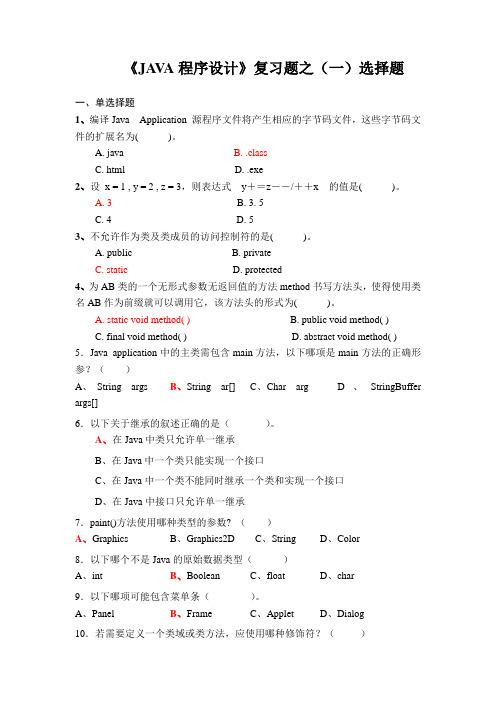
《JA V A程序设计》复习题之(一)选择题一、单选择题1、编译Java Application 源程序文件将产生相应的字节码文件,这些字节码文件的扩展名为( )。
A. javaB. .classC. htmlD. .exe2、设x = 1 , y = 2 , z = 3,则表达式y+=z--/++x 的值是( )。
A. 3B. 3. 5C. 4D. 53、不允许作为类及类成员的访问控制符的是( )。
A. publicB. privateC. staticD. protected4、为AB类的一个无形式参数无返回值的方法method书写方法头,使得使用类名AB作为前缀就可以调用它,该方法头的形式为( )。
A. static void method( )B. public void method( )C. final void method( )D. abstract void method( ) 5.Java application中的主类需包含main方法,以下哪项是main方法的正确形参?()A、String argsB、String ar[]C、Char argD、StringBuffer args[]6.以下关于继承的叙述正确的是()。
A、在Java中类只允许单一继承B、在Java中一个类只能实现一个接口C、在Java中一个类不能同时继承一个类和实现一个接口D、在Java中接口只允许单一继承7.paint()方法使用哪种类型的参数? ()A、GraphicsB、Graphics2DC、StringD、Color8.以下哪个不是Java的原始数据类型()A、intB、BooleanC、floatD、char9.以下哪项可能包含菜单条()。
A、PanelB、FrameC、AppletD、Dialog10.若需要定义一个类域或类方法,应使用哪种修饰符?()A、staticB、packageC、privateD、public11.在浏览器中执行applet 程序,以下选项中的哪个方法将被最先执行()。
JAVA期末复习题一
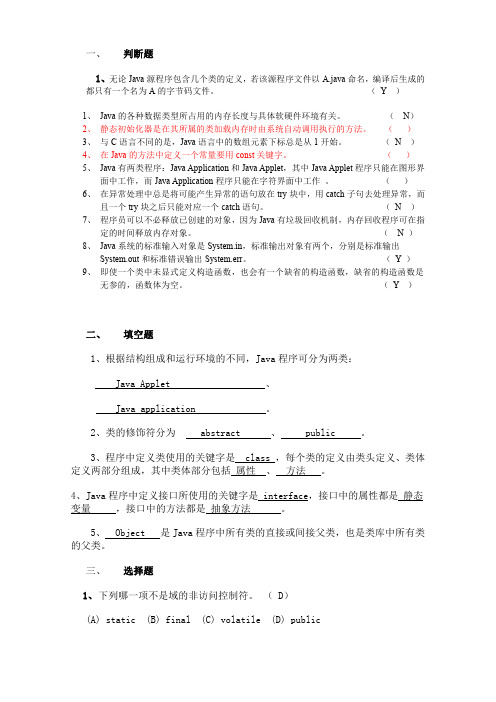
public class Test1{ public float aMethod(Float a, float b){} ***
} 将以下哪种方法插入行 *** 是不合法的。( ) (A) public float aMethod(float a,float b,float c){} (B) public float aMethod(float c,float d){} (C) public int aMethod(int a,int b){} (D) public float aMethod(int a,int b,int c){} 17、创建字符串 s: s=new String(“xyzy”);以下哪条语句将改变 s( D) (A) s.append(“a”) (B) s.concat(s) (C) s.substring(3) (D) 以上语句都不会 18、关于以下程序段,正确的说法是( B) String s1 = “ac”+ “def”; Strimg s2 = new String(s1); if(s1.equals(s2)) System.out.println(“==succeeded”); if(s1==s2) System.out.println(“.equals() succeeded”); (A) 行 4 与行 6 都将执行 (B)行 44 执行,行 6 不执行 (C) 行 6 执行,行 4 不执行 (D) 行 4、行 6 都不执行 19、关于以下代码段的说法正确的是(D ) String s = “abcde”; StringBuffer s1 = new StringBuffer(“abcde”); if(s.equals(s1))
()
6、 在异常处理中总是将可能产生异常的语句放在 try 块中,用 catch 子句去处理异常,而
面向对象原理与Java实践复习题集(1)
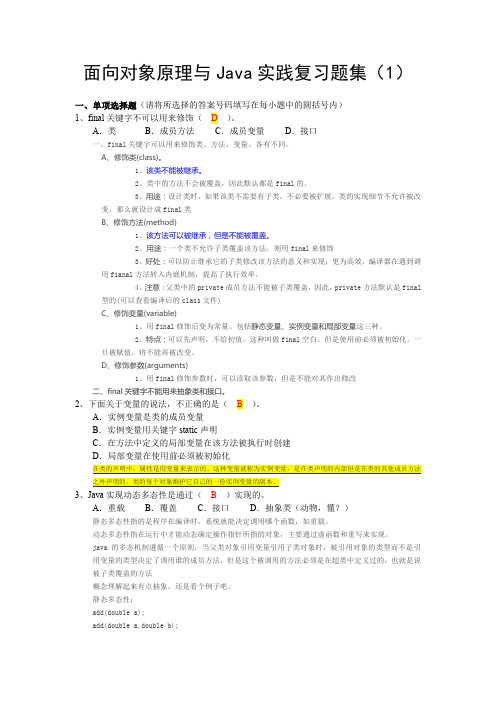
面向对象原理与Java实践复习题集(1)一、单项选择题(请将所选择的答案号码填写在每小题中的圆括号内)1、final关键字不可以用来修饰(D)。
A.类B.成员方法C.成员变量D.接口一、final关键字可以用来修饰类、方法、变量。
各有不同。
A、修饰类(class)。
1、该类不能被继承。
2、类中的方法不会被覆盖,因此默认都是final的。
3、用途:设计类时,如果该类不需要有子类,不必要被扩展,类的实现细节不允许被改变,那么就设计成final类B、修饰方法(method)1、该方法可以被继承,但是不能被覆盖。
2、用途:一个类不允许子类覆盖该方法,则用final来修饰3、好处:可以防止继承它的子类修改该方法的意义和实现;更为高效,编译器在遇到调用fianal方法转入内嵌机制,提高了执行效率。
4、注意:父类中的private成员方法不能被子类覆盖,因此,private方法默认是final型的(可以查看编译后的class文件)C、修饰变量(variable)1、用final修饰后变为常量。
包括静态变量、实例变量和局部变量这三种。
2、特点:可以先声明,不给初值,这种叫做final空白。
但是使用前必须被初始化。
一旦被赋值,将不能再被改变。
D、修饰参数(arguments)1、用final修饰参数时,可以读取该参数,但是不能对其作出修改二、final关键字不能用来抽象类和接口。
2、下面关于变量的说法,不正确的是(B)。
A.实例变量是类的成员变量B.实例变量用关键字static声明C.在方法中定义的局部变量在该方法被执行时创建D.局部变量在使用前必须被初始化3、Java实现动态多态性是通过(B)实现的。
A.重载B.覆盖C.接口D.抽象类(动物,懂?)静态多态性指的是程序在编译时,系统就能决定调用哪个函数,如重载。
动态多态性指在运行中才能动态确定操作指针所指的对象,主要通过虚函数和重写来实现。
java 的多态机制遵循一个原则:当父类对象引用变量引用子类对象时,被引用对象的类型而不是引用变量的类型决定了调用谁的成员方法,但是这个被调用的方法必须是在超类中定义过的,也就是说被子类覆盖的方法概念理解起来有点抽象。
JAVA期末复习题(一)
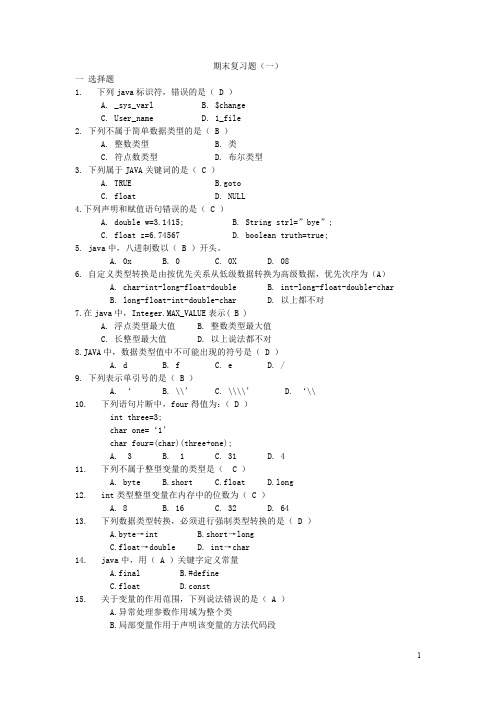
}
System.out.println(a);
}
}
A. 0
B. 2
C. 3
D. 4
36.下列数组定义及赋值,错误的是( B )
A.
int intArray[];
B.
intArray=new int[3];
intArray[1]=1;
intArray[2]=2;
intArray[3]=3;
C.
int a[]={1,2,3,4,5};
A.在 Java 中类只允许单一继承
B.在 Java 中一个类只能实现一个接口
C.在 Java 中一个类不能同时继承一个类和实现一个接口
C. swich
D. while
28. 多分支语句 switch(表达式){}中,表达式不可以返回哪种类型的值( C )
A. 整型
B. 实型
C. 接口型 D. 字符型
29.下面不属于 java 条件分支语句结构的是( D )
A. if 结构
B. if-else 结构
C. if-else if 结构
D. if-else else 机构
D.
int[][]=new int[2][];
a[0]=new int[3];
a[1]=new int[3];
37. 在 java 中,字符串由 ng.String 和( B )定义
A.
ng.StringChar
B.
ng.StringBuffer
C.
java.io.StringChar
52.要使某个类能被同一个包中的其他类访问,但不能被这个包以外的类访问,则( A )。
A.该类不使用任何关键字
B.使用 private 关键字
JAVA期末复习和答案(1)
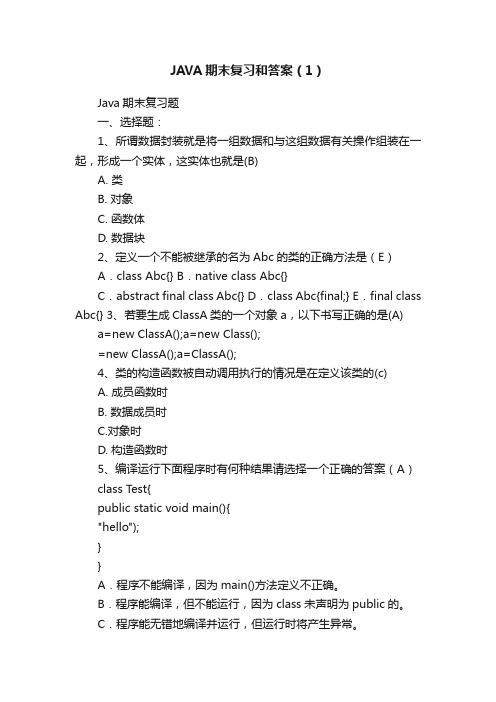
JAVA期末复习和答案(1)Java期末复习题一、选择题:1、所谓数据封装就是将一组数据和与这组数据有关操作组装在一起,形成一个实体,这实体也就是(B)A. 类B. 对象C. 函数体D. 数据块2、定义一个不能被继承的名为Abc的类的正确方法是(E)A.class Abc{} B.native class Abc{}C.abstract final class Abc{} D.class Abc{final;} E.final class Abc{} 3、若要生成ClassA类的一个对象a,以下书写正确的是(A) a=new ClassA();a=new Class();=new ClassA();a=ClassA();4、类的构造函数被自动调用执行的情况是在定义该类的(c)A. 成员函数时B. 数据成员时C.对象时D. 构造函数时5、编译运行下面程序时有何种结果请选择一个正确的答案(A)class Test{public static void main(){"hello");}}A.程序不能编译,因为main()方法定义不正确。
B.程序能编译,但不能运行,因为class未声明为public的。
C.程序能无错地编译并运行,但运行时将产生异常。
D.程序运行时显示“hello”。
6、关于抽象方法的说法正确的一项是(A)A、可以有方法体B、可以出现在非抽象类中C、抽象方法是没有方法体的方法D、抽象类中的方法都是抽象方法7、假定AB为一个类,则执行AB x=new AB( );语句时将自动调用该类的(B)A.有形参构造函数B.无形参构造函数C.其他成员函数D.重载函数8、编译并运行如下程序后,结果是什么请在给出的选项中选择出正确的答案(E)class Array{public static void main(String[] args){int length=100;int[] d=new int[length];for(int index=0;index<length;index++)< p="">}}A.因为int[]数组声明不正确,程序不能被编译。
Java复习题1
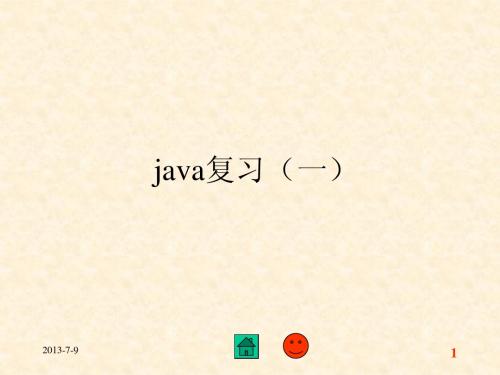
3
5、执行完语句int [ ]x = new int[25]; 后,则下列哪项说法是正确的( ) A.x[24]值为0 B.x[24]值未定义 C.x[25]值为0 D.x[0]值为空
2013-7-9
4
6、下列哪个选项是合法的标识符 ( A)123 B)_name C)class D)1first
2013-7-9
10
10、下列关于继承的哪项叙述是正确的? ( ) A)在java中允许多重继承 B)在java中一个类只能实现一个接口 C)在java中一个类不能同时继承一个 类和实现一个接口 D)java的单一继承使代码更可靠
2013-7-9
11
在java中一个类只能有一个直接父类,但 是可以实现多个接口,在继承的同时可 以实现接口,之所以取消多继承的原因 是多继承使得代码产生很多问题,而使用 单一继承则可以使代码更可靠。
2013-7-9
35
数组x定义如下 int x[ ][ ]=new int[3][2] 则 x.length 的值为____________, x[0].length 的值为____________。
2013-7-9
36
数组x定义如下 int x[ ][ ]=new int[3][2] 则 x.length 的值为______3______, x[0].length 的值为_____2_______。
2013-7-9
27
在 Java 中,所有类的根类是____。 A、ng.Objet B、ng.Class C、java.applet.Applet D、java.awt.Frame
2013-7-9
28
在 Java 中,所有类的根类是____。 A、ng.Objet B、ng.Class C、java.applet.Applet D、java.awt.Frame
JAVA考试复习题1(附答案)
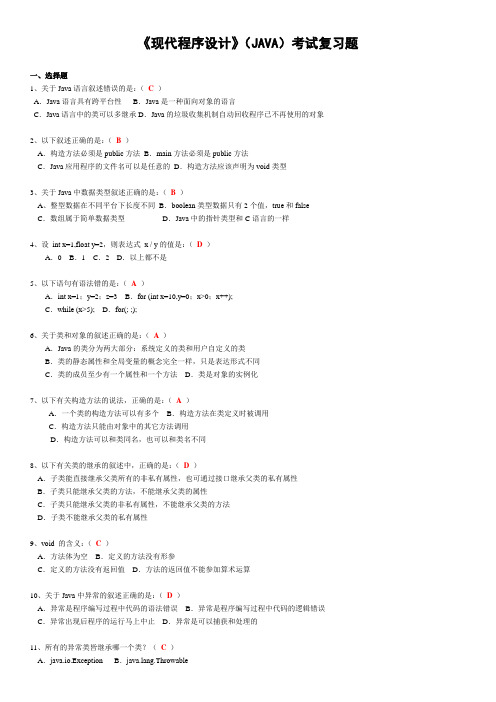
《现代程序设计》(JAVA)考试复习题一、选择题1、关于Java语言叙述错误的是:(C)A.Java语言具有跨平台性B.Java是一种面向对象的语言C.Java语言中的类可以多继承D.Java的垃圾收集机制自动回收程序已不再使用的对象2、以下叙述正确的是:(B)A.构造方法必须是public方法B.main方法必须是public方法C.Java应用程序的文件名可以是任意的D.构造方法应该声明为void类型3、关于Java中数据类型叙述正确的是:(B)A、整型数据在不同平台下长度不同B.boolean类型数据只有2个值,true和falseC.数组属于简单数据类型D.Java中的指针类型和C语言的一样4、设int x=1,float y=2,则表达式x / y的值是:(D)A.0 B.1 C.2 D.以上都不是5、以下语句有语法错的是:(A)A.int x=1;y=2;z=3 B.for (int x=10,y=0;x>0;x++);C.while (x>5); D.for(; ;);6、关于类和对象的叙述正确的是:(A )A.Java的类分为两大部分:系统定义的类和用户自定义的类B.类的静态属性和全局变量的概念完全一样,只是表达形式不同C.类的成员至少有一个属性和一个方法D.类是对象的实例化7、以下有关构造方法的说法,正确的是:(A)A.一个类的构造方法可以有多个B.构造方法在类定义时被调用C.构造方法只能由对象中的其它方法调用D.构造方法可以和类同名,也可以和类名不同8、以下有关类的继承的叙述中,正确的是:(D)A.子类能直接继承父类所有的非私有属性,也可通过接口继承父类的私有属性B.子类只能继承父类的方法,不能继承父类的属性C.子类只能继承父类的非私有属性,不能继承父类的方法D.子类不能继承父类的私有属性9、void 的含义:(C )A.方法体为空B.定义的方法没有形参C.定义的方法没有返回值D.方法的返回值不能参加算术运算10、关于Java中异常的叙述正确的是:(D )A.异常是程序编写过程中代码的语法错误B.异常是程序编写过程中代码的逻辑错误C.异常出现后程序的运行马上中止D.异常是可以捕获和处理的11、所有的异常类皆继承哪一个类?(C)A.java.io.Exception B.ng.ThrowableC.ng.Exception D.ng.Error12、下面哪个不是java语言中的关键字?(B)A.long B.sizeof C.instanceof D.const13、编译Java Application 源程序文件将产生相应的字节码文件,这些字节码文件的扩展名为( B)。
Java试题1

Aa=newB(); .
a.print();
}
}
a.A
b.B
c.AB
d.BA
15.现有两个类定义:
class Person{
public void Person(){
System.out.println("Person A");
String[] values = entry.getValue();
.......
}
16)尽量使用HashMap和ArrayList ,除非必要,否则不推荐使用HashTable和Vector,后者由于使用同步机制,而导致了性能的开销
17)rray(数组)和ArryList的使用
array([]):最高效;但是其容量固定且无法动态改变;
Java试题
一、单选
1.与JAVA无关的文件的是___d______
a.扩展名为CLASS的文件
b.扩展名为JAVA的文件
c.扩展名为JAR的文件
d.头文件
2.下列申明错误的是___d_,数组维数最大的是___b___
a.int[]z[];
b.String[][]z[];
c.char[]z;
d.float [5]z;
12.试分析下面的输出是__d___
int x=2;
x=3<<l/3&++x;
System.out.println(x);
a.0
b.1
c.2
d.3
13.请问下面的输出是___c__
int x=0x00000001;
x<<=3l;
04747Java语言程序设计(一)复习题汇总

Java语言程序设计(一)复习题一、选择题1、下面哪个不属于...Java语言的特点(C、编辑型)A、动态性B、面向对象C、编辑型D、多线型2、算符“&&”适用于数据类型()A、intB、longC、doubleD、boolean3、下列说法正确的是()A、不需定义类,就能创建对象B、属性可以是简单变量,也可以是一个对象C、属性必须是简单变量D、对象中必有属性和方法4、下面不是..合法Java标识符的是()A、abB、$_3C、3abD、ab35、下面不是..Java移位运算符的是()A、>>>B、<<<C、>>D、<<6、下面哪个不是..Java的关键字()A、doubleB、IntegerC、floatD、default7、下列算符中优先级别最高的是(C、!= )A、&B、&&C、!=D、?:8、关于main()方法说法正确的是()A、一个类中可以没有main()B、所有对象都必须放在main()方法中C、main()必须放在公共类中D、main()方法头的定义可以根据情况任意修改9、下列标签名中非法..的是()A、hereB、thereC、thisD、that10、下面各组中全部属于字型要素的是()A、字体、字形和大小B、字体、风格和字号C、字形、风格和字号D、字形、颜色和字号11、下列不是..构造方法特征的是()A、名字与类相同B、是无参考的C、是viod型D、是一种特殊方法12、关于代码“String [][]s=new String[10][];”的正确陈述是()A、该行代码非法B、s 是一10行10列的数组C、s 是一包含10个一维数组的二维数组D、s中每个元素设为""""""13、如想限制类本身对静态成员的访问,应该()A、用finalB、用privateC、不使用任何关键字D、不能限制14、下列不属于类的属性修饰符的是()A、publicB、abstractC、privateD、final15、一个创建对象的操作中,不包含...()A、释放内存B、对象声明C、分配内存D、调用构造方法16、下列关于封装性的说法中,错误..的是()A、是一种信息隐蔽技术B、使对象之间不可相互作用C、是受保护的内部实现D、与类有关,封装的基本单位是对象17、代码“new List (10,true);”的含义是()A、创建含10列的新列表B、创建含10行的新列表,且允许多重选择C、创建不多于10个选项的新列表D、创建含10行的新列表,每次选一项18、要为程序的子窗口设定一个由字符串s指定的名字,可以采用的代码是()A、JFrame(s)B、window(s)C、new JFrame(s)D、super(s)19、下列布局管理器中,哪一个会在前个组件相同行上放置组件,直到该组件超出容器的宽度,然后从新行开始,并把添加的组件居中放置()A、BorderLayoutB、CardLayoutC、FlowLayoutD、GridbagLayout20、滚动列表(List)每次选择选项,可以选择的个数是()A、1B、多个C、所有D、根据列表对象初始化参数确定21、Java源文件的扩展名是()A、.classB、.javaC、.javD、.cla22、Java注释方式不包括...C、/** … **/ ()23、下列说法正确的是()A、实例方法能对类变量和实例变量操作B、实例方法只能对类变量操作C、实例方法只能实例变量操作D、类方法能对类变量和实例变量操作24、下面均为Java关键字的一组是()A、boolean,byte,long,true " "B、byte, long,true,goto" "C、goto ,Boolean,byte,true" "D、bool, long,true,auto" "25、Java语言使用的字符集是()A、ASCIIB、EBCDICC、UnicodeD、BCD26、下面的四个选项中,均是八进制或十六进制数的是()A、-10,ox8f,011" "B、oabc,-017,oxc" "C、0010,-ox10,oxf1" "D、oa12,ox12,oxa " "27、下面的哪一项能正确生成5个空字符串()A、String a[]=new String [5]B、String 5[a]C、String [5]aD、String a[5]28、下列算符中优先级最低的是()A、++B、%C、?D、&29、Java中,一个类可以有几个父类(B、1 )A、任意B、1C、2D、430、类中不加任何访问权限限定的成员属于()A、defaultB、publicC、privateD、protected31、若有下面的类定义“class Bridge {Road road;} class Road{String name;}”它表示()A、"是什么"关系B、"有什么"关系C、二者都是D、二者皆不是32、this关键字的含义是表示一个()A、指针B、当前对象C、一个类D、一个方法33、一个消息的内容不包括...()A、消息接收者B、接受对象应采用的方法C、指示接受者做何处理D、方法的参数34、main()方法中有如下代码“Frame f=new Frame(""My Frame""); f.sd Size(100,100);”为在屏幕上显示该对象,应增加下面哪个代码()A、f.appear()B、f.set Foreground()C、f.set Visible()D、f.enable35、下列程序的执行结果是()public class Test{public static void main(String args[]){float t=9.0f; int q=5;System.out.println((t++)*(--q));}}A、40B、40.0C、36D、36.036、下列关于接口的说法,正确的是()A、接口与抽象类是相同的概念B、实现一个接口,必须实现接口的所有方法C、接口之间不能有继承关系D、一个类只能实现一个接口37、隐藏用户界面组件的指令是()A、disableB、setVisibleC、removeD、delete38、创建了一个选择控件对象后,将选项顺序加入到控件中的方法是()A、Choice ()B、remove (int)C、getSelectItem ()D、add (string)39、滚动列表(List)k可以产生几种事件()A、1B、2C、3D、440、设置组件的背景色可用方法()A、void setBackgroundColor(Color c)B、void setForegroundColor(Color c)C、void setBackground(Color c)D、void setForeground(Color c)41、Java的int型变量占内存的字节数是()A、1B、4C、2D、与机器有关42、下列选项中全部都是合法的实型常量的是()A、12.4,12,12.4f,12.4F" "B、12.0f,2e4f,12.0,6e-4" "C、6e,12.1,24f,25d" "D、13.6, 6e0.3,456.7d,e2" "43、下列说法错误..的是()A、一个类中的实例方法可以调用其他实例方法B、实例方法可以调用静态方法C、静态方法可以调用实例方法D、静态方法可以调用静态方法44、若定义int x=3,y;则执行语句y=(x++)+(x++)+(x++);后y= ()A、9B、12C、15D、1845、下面哪个是有效的Java标识符()A、max_numB、max-numC、3DogNightD、(train)46、以下关键字中哪一个是不可用来控制对类成员的访问()A、publicB、privateC、protectedD、default47、构造方法被调用是当()A、类定义时B、使用对象的属性时C、使用对象的方法时D、对象被创建时48、下列算符中优先级最高的是()A、+B、instanceofC、&&D、^49、不是面向对象技术特点的是()A、模块化B、封装C、继承性D、多态性50、接口体中不应..包含()A、常量定义B、常量赋值C、方法实现D、方法声明51、在成员变量与局部变量重名时,若想在方法内使用成员变量,要使用关键字()A、superB、importC、thisD、return52、下列定义中,哪一个是非法..的()A、class A{int a,b;…}" "B、class A{int i,j; i=j=10…}" "C、class A{int i; float f;…}D、class A{int i=12; float f1=1.2f;…}53、编译代码“class MySstring extends String{}”会出现的情况()A、成功编译B、不能编译,因为没有main方法C、不能编译,因为String是abstract类型的D、不能编译,因为String是final类型的54、若有定义“String tom=""boy"";String hill=""boy"";”则表达式(tom==hill)的值为()A、1B、trueC、falseD、055、下列关于继承的论述中,错误..的是()A、继承具有传递性B、继承关系也称为"即是"(is a)关系C、支持多继承D、继承提高了系统的可重用性56、为在容器底端放一个按钮,不管用户如何改变尺寸,用下面哪个布局管理器最简单()A、BorderLayoutB、GridLayoutC、FlowLayoutD、GridbagLayout57、把组件放在BorderLayout的下列哪个区域时,它会自动垂直调整大小,但不水平调整。
- 1、下载文档前请自行甄别文档内容的完整性,平台不提供额外的编辑、内容补充、找答案等附加服务。
- 2、"仅部分预览"的文档,不可在线预览部分如存在完整性等问题,可反馈申请退款(可完整预览的文档不适用该条件!)。
- 3、如文档侵犯您的权益,请联系客服反馈,我们会尽快为您处理(人工客服工作时间:9:00-18:30)。
//p, t and s are all non-null. if(t instanceof Person) { s = (Student)t; } 最后一句语句的结果是: A 将构造一个 Student 对象; B 表达式是合法的; C 表达式是错误的; D 编译时正确,但运行时错误。 25.对于下列代码: 1) class Person { 2) public void printValue(int i, int j) {//... } 3) public void printValue(int i){//... } 4) } 5) public class Teacher extends Person { 6) public void printValue() {//... } 7) public void printValue(int i) {//...} 8) public static void main(String args[]){ 9) Person t = new Teacher(); 10) t.printValue(10); 11) } 第 10 行语句将调用哪行语句?? A line 2 B line 3 C line 6 D line 7 26.要从文件" file.dat"文件中读出第 10 个字节到变量 C 中,下列哪个方法适 合? A、 FileInputStream in=new FileInputStream("file.dat"); in.skip(9); int c=in.read(); B、 FileInputStream in=new FileInputStream("file.dat"); in.skip(10); int c=in.read(); C、 FileInputStream in=new FileInputStream("file.dat"); int c=in.read(); D、 RandomAccessFile in=new RandomAccessFile("file.dat"); in.skip(9); int c=in.readByte(); 27.指出下列程序运行的结果 public class Example{ String str=new String("good"); char[]ch={'a','b','c'}; public static void main(String args[]){ Example ex=new Example(); ex.change(ex.str,ex.ch); System.out.print(ex.str+" and "); Sytem.out.print(ex.ch); } public void change(String str,char ch[]){ str="test ok"; ch[0]='g'; }
{
A() {System.out.print(“A”); } } public class B extends A { public static void main(String[] args) { B b=new B(); A a=new A(); }
} 关于上述程序代码的叙述中正确的是() A、没有输出任何信息 B、不能通过编译 C、程序通过编译,输出结果为 A D、程序通过编译,输出结果为 AA 10、下列关于修饰符说法中错误的是() A、ABSTRACT 不能与 FINAL 一起修饰同一个类 B、STATIC 方法中可以处理非 STATIC 的成员变量 C、ABSTRACT 方法必须在 ABSTRACT 类中 D、在接口中,若定义成员变量时没有修饰符,那么该成员变量默认为公有的, 最终的和静态的 11、若要在一个接口中声明一个无返回值的方法 PLAYA() ,那么声明这个方法 的形式可以是() A .public final void playa() B .public void playa() C .private void playa(double d) D .protected void playa(double d) 12.设类 B 和类 C 都不是抽象类,且类 B 是类 C 的父类。下列声明对象 x1 的语 句中不正确的是( ) 。 A. B x1=new B(); B. B x1=new C(); C. C x1=new C(); D. C x1=new B() 13、下列判断 JAVA 程序结构说法有错误的是() A、package 语句必须主在源文件的第一句 B、源文件可以没有 import 语 C、一个源文件可以有多个类定义 D、一个源文件可以定义多个 public 类 14、下面的程序第 7 行创建了一个文件输出流对象,用来向文件 test.txt 中输 出数据, 假设程序当前目录下不存在文件 test.txt,编译下面的程序 Test.java 后,将该程序运行两次,则文件 test.txt 的内容是( )。 1: import java.io.*; 2: public class Test { 3: public static void main(String args[]) {
4: try { 5: String s="ABC"; 6: byte b[]=s.getBytes(); 7: FileOutputStream file=new FileOutputStream("test.txt",true); 8: file.write(b); 9: file.close(); 10: } 11: catch(IOException e) { 12: System.out.println(e.toString()); 13: } 14: } 15: } A) ABC ABC B) ABC C)Test D) Test Test 15、java 语言是() A、机器语言 B、汇编语言 C、面向过程的语言 D、面向对象的 语言 16、下列()是反斜杠字符的正确表示 A、\ B、\\ C、\* D、 ”\ 17.执行下列语句的,a,b 的值为() int a=2; double b=3.4; a=(int)b; A、3、3 B、3、3.4 C、2、3 D、2、3.4 18.下列代码的执行结果为() public class a {public static void main(String [] args) { int a=2,b=2,c=3; String s=”abc”; System.out.println(a+b+ s +c); } } A、22abc3 B、4abc3 C、ababcc D、221233 19.下面是 findSum(int m,int n)方法的定义,方法调用 findSum(1,4)的返回 结果是( )。 int findSum(int m,int n) { int sum=1; for(int i=m;i<=n;i++) { sum*=i; } return sum; } A、 4 B、 24 C、ut.println(k); B. 5 D. 12
A. 3 C. 8 5.有以下程序 public stati c void main(String args[]) { int x=0,y=5,z=3; while(z>0&&x<4) { y=y-1; z--; x++; } System.out.println (x+”,”+y+”,”+z);} 以上程序段的输出结果是() A、3,2,0 B、3,2,-1 C、4,3,-1 D、5,-2,-5 6. 下面的程序段输出的结果是( ) 。 int i=1,b,c; int[] a=new int[3]; b=a[i]; c=b+i; System.out.println(c); A. 0 B. 2 C. 1 D. 4 7. 按命令行:java Test Red Green Blue 执行下面的程序后,bar 的值是() public class Test{ public static void main(String[] args){ String foo=args[0]; String bar=args[1]; String baz=args[2]; } } A)"Green" B)"Test" C)"Red" D)"Blue " 8. 1)public class X{ 2) public static void main(String[] args){ 3) String foo="ABCDE"; 4) foo.concat("XYZ"); 5) } 6) } 当程序执行到第 5 行时 foo 的值为:( ) A) "ABCDE" B)"ABCDEXYZ" C) 值为空 D)编译出错 9.类 A 及其子类 B 定义如下: class A
